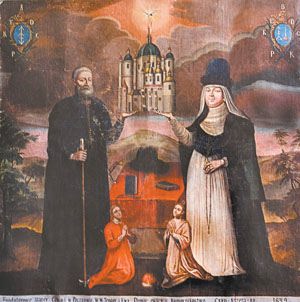150 Shrines of Great Volhynia
Ukrainian Medieval and Renaissance art is an implicit evidence that we belong to European culture
To help the readers feel the continuity of Ukrainian art traditions and understand deeper their own cultural heritage – this task was set by the authors of the photo album 150 Shrines of Great Volhynia, created at the Ostroh Academy. A collection of icons, paintings, sculptures, frescoes, mosaics, and incunabula covers only six oblasts: Rivne, Volyn, Lviv, Ternopil, Zhytomyr, and Khmelnytsk. However, the artistic heritage of this region is significantly wider in its essence, and is often a reflection of major art tendencies of Ukrainian culture.
For example, Old Rus’ art found is reflected in Volhynian art. This is evident from the Kholmska Bohorodytsia (the icon of Our Lady of Kholm). Fragments of the adornments from this icon are made of precious metals and represent the capital city of Kyiv, whose traditions were to be followed for a long time in Volhynia.
A lot of works presented in the album are now in private collections, often outside Ukraine, that is why they deserve special attention. And works by Ukrainian icon painters, which differ from Byzantine icon art by their special vividness and liveliness, were considered to be lost for a long time. Only the work of the museum staff and restorers allowed to not only return certain works from oblivion, but also to gather collections of 12th-18th century icons, without which it is impossible to write the history of Ukrainian art today.
Renaissance portrait painting is not widely known to Ukrainians, but it is especially vital for understanding Ukrainian Renaissance culture. It was highly developed in Volhynia, which has been the home to Ukrainian nobility during the Renaissance. By the way, this trend in art, which was considerably influenced by Dutch painting, helps understand the history of Ukrainian aristocratic families better, says art historian Dmytro Antonovych. It is remarkable that collections of portrains of highborn ancestors were found not only in castles and palaces, but in small estates that belonged to petty gentry.
A favorable geographical location, the development of trade, crafts, and agriculture promoted the prosperity of Volhynian towns, where the centers of new culture arose in the 13th-16th centuries. And since wealthy nobility, the church, and rich townsfolk were the painters’ main clients, it is chiefly their tastes that defined the specific character of Volhynian art, says artist and restorer Mykola Bendiuk, one of the compilers of the album. But at the same time, this art was not rigid or provincial, and often, though maybe sometimes with delay, it absorbed European cultural traditions of the time. Visiting European masters worked in Volhynian towns, especially those invited by the princes of Ostroh. Two massive bronze candleholders from Dubno, cast in 1575 by a Gdansk crafter Luka Friedland, who was hired by Kostiantyn Ostrozky, are an example of combination of local and foreign traditions.
The authors of the photo album, among whom also are historian Viktor Luts and photo artist Oleksandr Kharvat, did pay attention to the art of book making and decoration in Volhynia, which has ancient traditions and is essential for understanding the cultural life of the region. Suffice it to mention the famous Peresopnytske Yevanhelie (the Peresopnytsia Gospels). The princes of Ostroh posessed some precious manuscripts, among which were Turivske Evanhelie (the Turiv Gospels) of the 11th century, which was a gift to Preobrazhenska (Transfiguration) church in Turiv in 1508. Supplementary records state that the precious books, gift from the Ostroh brothers, were kept at the monasteries of Derman and Dorohobuzh and the churches of Dubno. The work of the printing house in Ostroh undoubtedly became the biggest achievement in the field of book making. Ostroh printing traditions found its continuation in the work of Ukrainian print shops of the 17th-18th centuries, especially the Pochaiv print shop.
As a matter of fact, the art of Great Volhynia is a whole layer of Ukrainian culture that still requires proper interpretation, fills in the gaps created by soviet historiography, and, in a way, even turns our idea of history upside down. And it is all because these works of art were created in an open and dynamic society, so typical for Medieval or Renaissance Europe, which we are striving to bring back.






